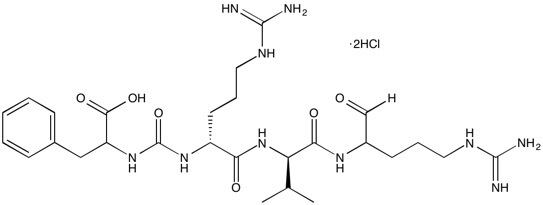Antipain 2HCl | Serine and cysteine protease inhibitor
NMR (Conforms)

Available Options
| Size : | Price | Quantity | |
|---|---|---|---|
| 5 mg | $35.00 | ||
| 25 mg | $140.00 |
Antipain 2HCl (CAS 37682-72-7) is a serine/cysteine protease inhibitor. Also inhibits some trypsin-like proteases.1 May be used as an additive to prevent proteolytic activity during recombinant protein production in Sf-9 insect cell cultures.2 May be employed in the characterization of newly discovered proteases.3,4 Blocks autophagy in cultured tobacco cells and may be used in an assay for autophagy in plant cells.5
References/Citations:
1) Umezawa et al. (1976), Structures and activities of protease inhibitors of microbial origin; Method Enzymol., 45 678
2) Gotoh et al. (2001), Proteolytic activity and recombinant protein production in virus-infected Sf-9 insect cell cultures supplemented with carboxyl and cysteine protease inhibitors; J. Biosci. Bioeng., 92 248
3) Hockensmith et al. (2016), Identification and characterization of a chymotrypsin-like serine protease from periodontal pathogen, Tannerella forsythia; Microb. Pathog., 100 37
4) Mat Amin et al. (2004), Proteinases in Naegleria Fowleri (strain NF3), a pathogenic amoeba: a preliminary study.; Trop. Biomed., 21 57
5) Moriyyasu & Inoue (2008), Use of protease inhibitor for detecting autophagy in plants; Methods Enzymol., 451 557
NMR (Conforms)
Safety Data Sheet:
Product Data Sheet:
Materials provided by Focus Biomolecules are for laboratory research use only and are not intended for human or veterinary applications. Please note that we do not sell to individuals and that all orders placed by non-research organizations will incur a $20 restocking/refund fee
Antipain 2HCl (CAS 37682-72-7) is a serine/cysteine protease inhibitor. Also inhibits some trypsin-like proteases.1 May be used as an additive to prevent proteolytic activity during recombinant protein production in Sf-9 insect cell cultures.2 May be employed in the characterization of newly discovered proteases.3,4 Blocks autophagy in cultured tobacco cells and may be used in an assay for autophagy in plant cells.5
References/Citations:
1) Umezawa et al. (1976), Structures and activities of protease inhibitors of microbial origin; Method Enzymol., 45 678
2) Gotoh et al. (2001), Proteolytic activity and recombinant protein production in virus-infected Sf-9 insect cell cultures supplemented with carboxyl and cysteine protease inhibitors; J. Biosci. Bioeng., 92 248
3) Hockensmith et al. (2016), Identification and characterization of a chymotrypsin-like serine protease from periodontal pathogen, Tannerella forsythia; Microb. Pathog., 100 37
4) Mat Amin et al. (2004), Proteinases in Naegleria Fowleri (strain NF3), a pathogenic amoeba: a preliminary study.; Trop. Biomed., 21 57
5) Moriyyasu & Inoue (2008), Use of protease inhibitor for detecting autophagy in plants; Methods Enzymol., 451 557
Calculate the molar concentration, mass or volume in a solution.
Concentration × Volume × Molecular Weight = Mass
Focus Biomolecules • Plymouth Meeting, PA USA • 1-855-FOCUS21
Focus Biomolecules
Plymouth Meeting, PA USA
1-855-FOCUS21
Website Created by Advanta Advertising LLC.

